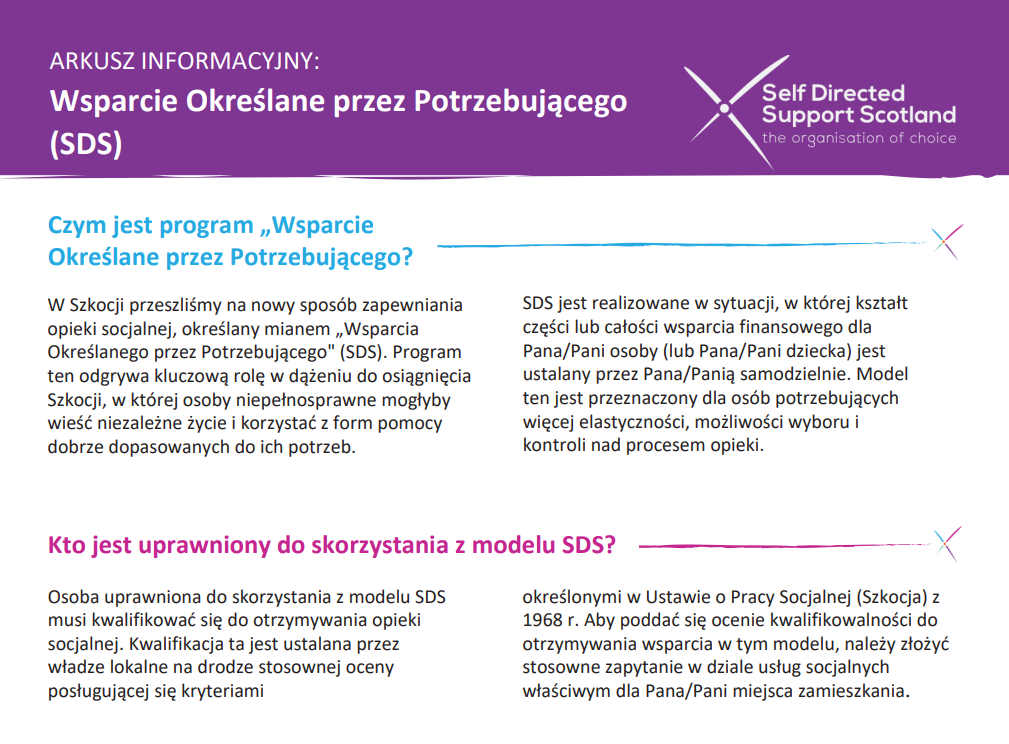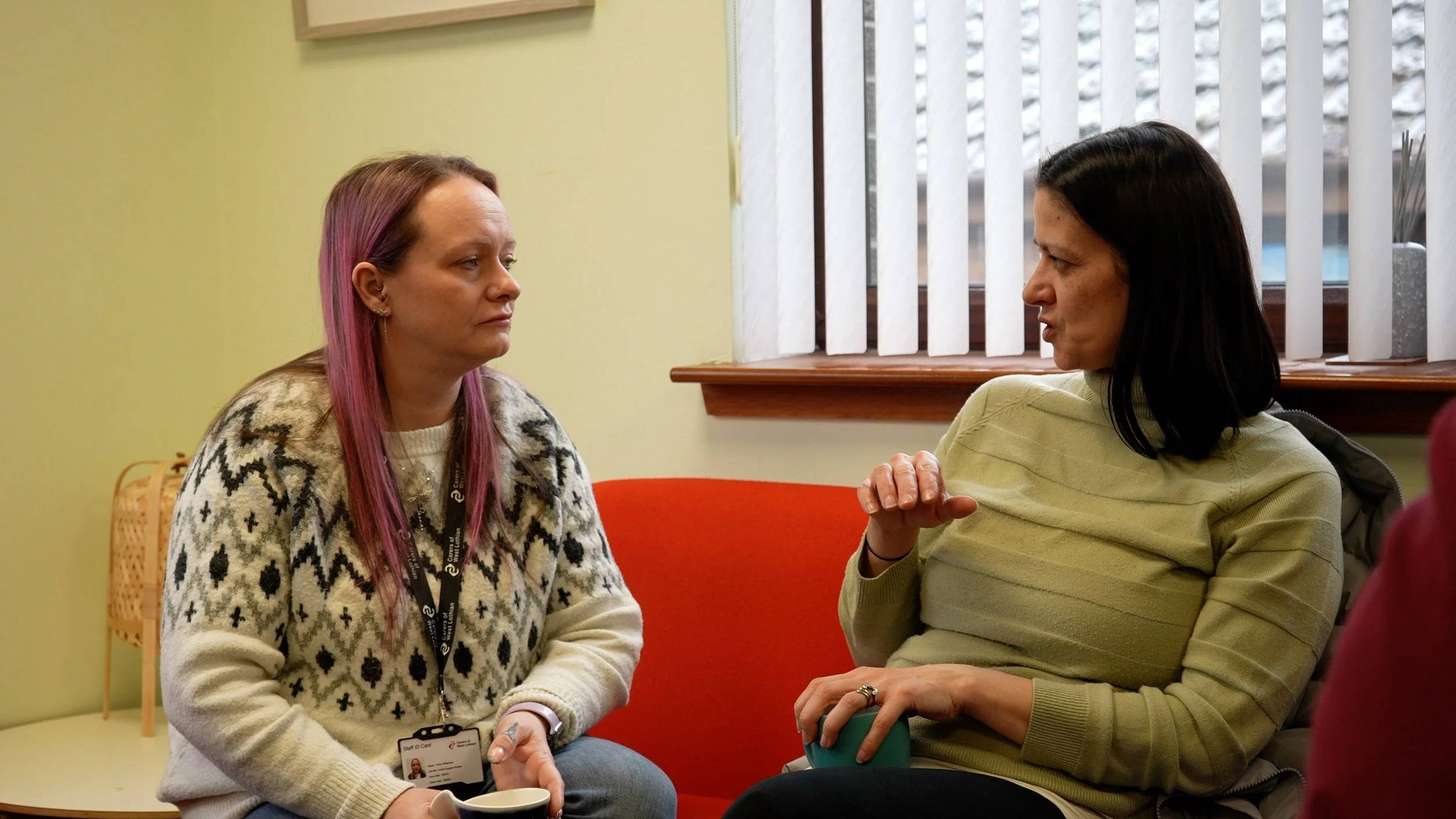Self-Directed Support
Self-Directed Support (SDS) is Scotland’s way of giving you choice in the care and support you receive. It’s all about putting you in control, ensuring your support fits your life, your needs and your goals. SDS is built on key principles, respect, fairness, independence and working together.
Whether you're an unpaid carer or someone needing support yourself, SDS helps you make choices that work for you.
What is Self-Directed Support (SDS)?
Self-Directed Support (SDS) is the way people in Scotland can arrange their social care and support. It puts you at the centre, giving you the chance to choose how your support is planned and delivered, so it works for your life.
SDS is based on person-centred values, meaning your support is tailored to your individual needs, preferences, and goals.
To access SDS, you’ll need to have an assessment to look at your needs and what you want to achieve. If you’re assessed as eligible, you can choose from four flexible options for how your support is provided. If you’re not eligible, you will still be offered advice, signposting, or other forms of help.
SDS is all about giving you choice, control, and the confidence to shape the support that’s right for you.
Self-Directed Support Options
-

Option One: A Direct Payment
You can use this to choose and control your support e.g. employing a personal assistant
-

Option Two: Individual Service Fund
You choose what support you would like and the Local Authority makes the arrangement
-

Option Three: Direct Service
The Local Authority selects the support and arranges it.
-

Option Four: Mix & Match
You choose a mix of the available options that works for you.
Find out more about
Self-Directed Support
If you’re looking to find out more information about SDS, we’re here to give you all the help you may need.
If you are eligible for formal social care support, you should be offered different options for how this is provided. These options are designed to give you the level of responsibility you would like.
Some people want to be responsible for all aspects of their support, including employing their own support staff.
Some people feel comfortable to take on the additional responsibilities this brings. They feel that this option offers the most control, choice and input for how they receive their own support and who delivers it.
Carers of West Lothian offer regular SDS-centred workshops, covering a range of key points and topics. These run regularly and are offered both in-person or via Zoom.
You can also get in touch with us, and our dedicated SDS worker will talk you through your options, and provide advice for your next steps.
Upcoming events.
It all begins with an idea. Maybe you want to launch a business. Maybe you want to turn a hobby into something more. Or maybe you have a creative project to share with the world. Whatever it is, the way you tell your story online can make all the difference.
Case study
Carol is an unpaid carer for her husband, who is living with dementia.
Carol explains how she was able to take control of the support she needed.
Punjabi
Introduction to Self-Directed Support in Scotland
Access to the basic information regarding Self-Directed Support (SDS) in various community languages.
Urdu
Polish
Bengali
Arabic
Cantonese
About our support and services
Your most asked questions about Self Directed Support
-
Critical risk or urgent need
If you are at critical risk or in urgent need, this means there may be an immediate risk to your safety.
You may not be able to look after yourself without support, or do things like go to work or college, which limits your independence.
You might rely on a family member or carer for help, but this is putting their health and wellbeing at risk.
If you are at critical risk or in urgent need, you are likely to be eligible for formal social care support through your council.
Substantial risk or high level of need
If you are at substantial risk, this means there may be a significant risk to your safety.
You might be able to do some things to look after yourself, but not everything you need to be able to do.
If you are at substantial risk, you are likely be eligible for formal social care support through your council, but it might take longer to put in place.
Moderate risk or moderate level of need
If you are at moderate risk, this means there is probably not any risk to your safety.
You may struggle to do some things to look after yourself, but can manage other things.
If you are at this level, it is unlikely you will be eligible for formal social care support through your council.
Low risk or low level of need
If you are at low risk, there may be one or two things you cannot do to look after yourself, or that you find difficult to manage.
If you are at this level, it is very unlikely you will be eligible for formal social care support through your council.
-
Your Support Plan can be recorded in any way, whatever suits you best. It could be written down, on film, drawn, or displayed in another way.
A good Support Plan should be based on a description of the support you need and not the amount of time you have been given for you to receive support each week.
A good Support Plan should be positive, and not just based on what you cannot do. It should include information about what you can do, and what else you want to do with help.
A good Support Plan should include details of what informal support you already get as well as formal, funded support.
A good Support Plan should include details of how your support should be provided.
For example, if you need support showering, this should include details of how you should be supported to take a shower. It should not say just ‘shower’.
You should get a copy of your Support Plan (if you want it) and it should be an accurate summary of what has been agreed with you.
-
You can choose how much direct control and responsibility you want to have for managing your budget.
You can decide how to use your budget, and handle the money yourself (with help if from someone else if you need it)
You can decide how to use your budget, but get someone else to handle the money for you
You can let your council decide how best to use your budget.
The amount of budget you get may be different depending on which of these options you choose.
This is because it costs different amounts of money to arrange support in different ways.
-
The process of leaving hospital is sometimes known as discharge.
If you did not have social care support before you went into hospital, but you are likely to need it when you leave, this should be arranged while you are in hospital.
To work out what you might need support with, you will have an assessment. This may involve several people including doctors, other medical professionals, a social worker or occupational therapist.
The assessment is about finding out what is important to you and what you may need support with once you leave hospital.
The hospital should also create a Discharge Plan with you.
You can ask for a copy of your Discharge Plan.
Family members’ and unpaid carers’ role in getting ready to leave hospital
You may have people helping you, for example family members, while you are in hospital or when you leave.
Your assessment should also find out what support anyone who is caring for you needs, once you leave hospital.
Family members and unpaid carers also have a right to be involved in planning your discharge from hospital.
For more info, take a look at the SDS Scotland Handbook.
-
Unfortunately, trying to understand or change a decision you do not agree with can be a frustrating process.
It is helpful to keep a record of all the times you try to contact someone about the issue, for example, emails, phone calls, attending enquiries desks, meeting requests.
It can also be useful to get help from a local Independent Support Organisation or Advocacy Service if you are trying to challenge a decision.
Our factsheet may help you with next steps.
-
By law, your council must offer most people all four options for how to organise your support.
However, there are some exceptions when they do not have to offer you all options.
Option 1 is the option with most responsibility, where the council give you money to purchase your own support.
Your council can say that Option 1 is not suitable if:
your safety would be put at risk by being given money directly
you need long term residential care or nursing care
you have had Option 1 in the past and it had to be stopped for some reason.
If your council decides they are not going to offer you Option 1, they should explain clearly to you why this is.
As a person eligible for support, you are usually legally entitled to be offered all four options.
But, in some parts of Scotland, not every option is available. This might be because there are no care organisations that provide the type of support you need.
If this is the case, your social worker should still explain what the options are and whether each one of them is available.
Regardless of what options are available locally to you, your social worker should still ask you how much control and responsibility you want to have in arranging your support.
They should work with you to help you get as close to the level of responsibility that you want. This is working within what is possible from the available options.
More questions?







